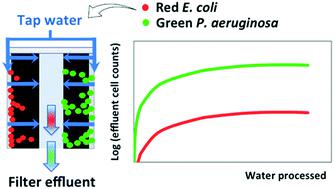当前位置:
X-MOL 学术
›
Environ. Sci.: Water Res. Technol.
›
论文详情
Our official English website, www.x-mol.net, welcomes your
feedback! (Note: you will need to create a separate account there.)
Bacterial transmission and colonization in activated carbon block (ACB) point-of-use (PoU) filters
Environmental Science: Water Research & Technology ( IF 3.5 ) Pub Date : 2021-5-4 , DOI: 10.1039/d0ew00982b Chia-Chen Wu 1 , Nancy G. Love 2 , Terese M. Olson 2
Environmental Science: Water Research & Technology ( IF 3.5 ) Pub Date : 2021-5-4 , DOI: 10.1039/d0ew00982b Chia-Chen Wu 1 , Nancy G. Love 2 , Terese M. Olson 2
Affiliation

|
Drinking water bacteria are known to colonize commercial activated carbon block (ACB) point-of-use (PoU) drinking water filters. The breakthrough pattern of drinking water bacteria through these filters, however, is unclear. A manifold system was constructed with two of the most common filter brands in the U.S. and operated to simulate normal household diurnal use. The filters were fed tap water inoculated with two fluorescent-tagged bacterial species that were acclimated to drinking water conditions (GFP-Pseudomonas aeruginosa and mCherry-Escherichia coli). Separate breakthrough tests with abiotic fluorescent microspheres (1 μm) were also conducted. The fluorescent P. aeruginosa and E. coli strains were detected in filter effluent within the first 6 and 28 L processed, respectively. The fluorescent microspheres were also detected in the effluent within the first 6 L processed, indicating that preferential flow pathways with diameters larger than 1 μm allow influent particles to transit the entire thickness of the carbon block. P. aeruginosa broke through the filters more quickly than E. coli, possibly due to its smaller cell size. P. aeruginosa also displayed greater colonization advantages over E. coli, and its effluent cell number plateaued at levels two times the influent level. This study provides evidence that some bacteria, including species known to include opportunistic and enteric pathogenic strains, can be readily transmitted through solid block activated carbon filters and that these filters can elevate the levels of effective colonizers in drinking water.
中文翻译:

活性炭块(ACB)使用点(PoU)过滤器中的细菌传播和定殖
众所周知,饮用水细菌会在商用活性炭块(ACB)使用点(PoU)饮用水过滤器中定植。然而,不清楚饮用水细菌通过这些过滤器的突破方式。歧管系统由美国两个最常见的过滤器品牌组成,用于模拟正常的家庭日间使用。给滤池喂以自来水,该自来水接种了两种带有荧光标签的细菌,这些细菌已适应饮用水条件(GFP-铜绿假单胞菌和mCherry-大肠杆菌)。还使用非生物荧光微球(1μm)进行了单独的穿透测试。荧光铜绿假单胞菌和大肠杆菌在最初处理的6 L和28 L的过滤器流出物中分别检测到菌株。在最初处理的6 L废水中也检测到荧光微球,这表明直径大于1μm的优先流动路径允许流入的颗粒通过碳块的整个厚度。铜绿假单胞菌比大肠杆菌更快地通过过滤器,这可能是由于其较小的细胞大小。铜绿假单胞菌也显示出比大肠杆菌更大的定殖优势,其出水细胞数量稳定在进水水平的两倍。这项研究提供了证据,表明某些细菌(包括已知包括机会病和肠道致病菌的细菌)可以很容易地通过固体块状活性炭过滤器传播,并且这些过滤器可以提高饮用水中有效定殖剂的水平。
更新日期:2021-05-04
中文翻译:

活性炭块(ACB)使用点(PoU)过滤器中的细菌传播和定殖
众所周知,饮用水细菌会在商用活性炭块(ACB)使用点(PoU)饮用水过滤器中定植。然而,不清楚饮用水细菌通过这些过滤器的突破方式。歧管系统由美国两个最常见的过滤器品牌组成,用于模拟正常的家庭日间使用。给滤池喂以自来水,该自来水接种了两种带有荧光标签的细菌,这些细菌已适应饮用水条件(GFP-铜绿假单胞菌和mCherry-大肠杆菌)。还使用非生物荧光微球(1μm)进行了单独的穿透测试。荧光铜绿假单胞菌和大肠杆菌在最初处理的6 L和28 L的过滤器流出物中分别检测到菌株。在最初处理的6 L废水中也检测到荧光微球,这表明直径大于1μm的优先流动路径允许流入的颗粒通过碳块的整个厚度。铜绿假单胞菌比大肠杆菌更快地通过过滤器,这可能是由于其较小的细胞大小。铜绿假单胞菌也显示出比大肠杆菌更大的定殖优势,其出水细胞数量稳定在进水水平的两倍。这项研究提供了证据,表明某些细菌(包括已知包括机会病和肠道致病菌的细菌)可以很容易地通过固体块状活性炭过滤器传播,并且这些过滤器可以提高饮用水中有效定殖剂的水平。











































 京公网安备 11010802027423号
京公网安备 11010802027423号